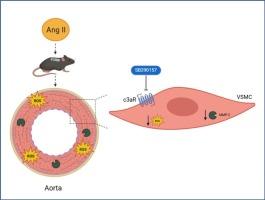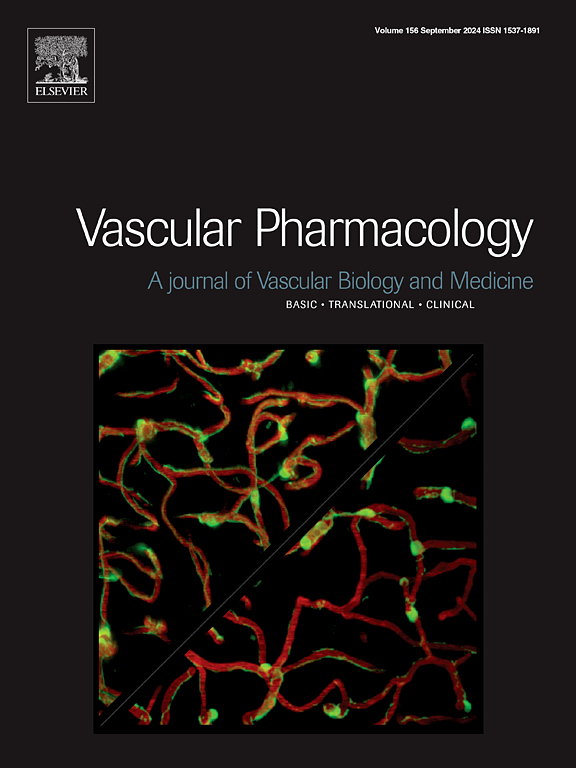补体受体拮抗可降低血管紧张素ii诱导的高血压小鼠主动脉氧化应激和基质金属蛋白酶(MMP)-2活性。
IF 3.5
3区 医学
Q2 PHARMACOLOGY & PHARMACY
引用次数: 0
摘要
血管紧张素II (angii)通过其受体增加C3a的作用,促进主动脉氧化应激和上调基质金属蛋白酶(MMP)-2。MMP-2与高血压患者肥厚性动脉重塑有关。本研究探讨了C3a受体激活是否导致Ang II处理小鼠主动脉氧化应激和MMP-2活性升高,最终导致血管的不适应改变。在C57BL/6小鼠皮下植入注入Ang II(1000 ng/kg/min)的渗透性微型泵,持续14 天诱导高血压。小鼠每隔一天给予C3aR拮抗剂SB290157(1 mg/kg/天,腹腔注射),共14 天。收缩压(SBP)和血管功能评估通过直接血压测量和收缩和松弛分析在钢丝肌图。采用凝胶和原位酶谱法分析主动脉MMP-2活性。SB290157不降低收缩压、主动脉肥厚或增加对苯肾上腺素的主动脉反应性。Ang II表现出血浆中C3a水平升高,肾脏中肿瘤坏死因子(TNF)-α和白细胞介素(IL)-6水平升高(*p本文章由计算机程序翻译,如有差异,请以英文原文为准。

Antagonism of the complement receptor reduces oxidative stress and matrix metalloproteinase (MMP)-2 activity in the aortas of mice with angiotensin-II-induced hypertension
Angiotensin II (Ang II) increases C3a effects through its receptors, promoting aortic oxidative stress and upregulating matrix metalloproteinase (MMP)-2. MMP-2 is implicated in hypertrophic arterial remodeling in hypertension. This study investigated whether C3a receptor activation contributes to oxidative stress and increased MMP-2 activity in aortas of Ang II treated mice, ultimately leading to maladaptive vascular changes. Hypertension was induced in C57BL/6 mice via subcutaneous implantation of osmotic mini pumps delivering Ang II (1000 ng/kg/min) for 14 days. Mice were administered the C3aR antagonist, SB290157 (1 mg/kg/day, intraperitoneally) every other day for 14 days. Systolic blood pressure (SBP) and vascular function were assessed via direct blood pressure measurements and contraction and relaxation analysis in a wire myography. Aortic MMP-2 activity was analyzed by gel and in situ zymography. SB290157 did not decrease SBP, aortic hypertrophy or increased aortic reactivity to phenylephrine in Ang II treated mice. Ang II exhibited higher levels of C3a in the plasma and increased tumor necrose factor (TNF)-α and interleukin (IL)-6 in the kidneys (*p < 0.05). SB290157 did not alter C3a, but reduced TNF-α and IL-6 in hypertension (#p < 0.05 vs. Ang II). SB290157 also decreased aortic oxidative stress and p65 factor nuclear kappa B (NFkB) in Ang II treated mice (*p < 0.05). MMP-2 activity was increased in the aortas of Ang II (*p < 0.05) and SB290157 decreased it (*p < 0.05). Pharmacological antagonism of C3a receptor attenuates oxidative stress and MMP-2 activity in the aortas of Ang II treated mice.
求助全文
通过发布文献求助,成功后即可免费获取论文全文。
去求助
来源期刊

Vascular pharmacology
医学-药学
CiteScore
6.60
自引率
2.50%
发文量
153
审稿时长
31 days
期刊介绍:
Vascular Pharmacology publishes papers, which contains results of all aspects of biology and pharmacology of the vascular system.
Papers are encouraged in basic, translational and clinical aspects of Vascular Biology and Pharmacology, utilizing approaches ranging from molecular biology to integrative physiology. All papers are in English.
The Journal publishes review articles which include vascular aspects of thrombosis, inflammation, cell signalling, atherosclerosis, and lipid metabolism.
 求助内容:
求助内容: 应助结果提醒方式:
应助结果提醒方式:


